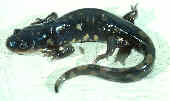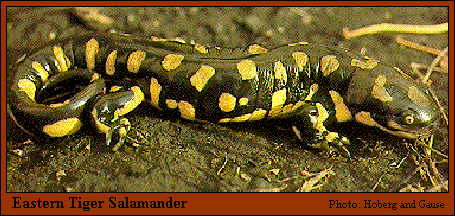![[Picture of Tiger SALAMANDER]](salameastiger10.gif)
Learn About The Endangered TIGER SALAMANDER

TIGER SALAMANDER SCIENTIFIC CLASSIFICATION
| KINGDOM |
Animalia |
| PHYLUM |
Chordata |
| CLASS |
Amphibia |
| ORDER |
Caudata |
| FAMILY |
Ambystomatidae |
| GENUS |
Ambystoma |
| SPECIES |
tigrinum |
| SUBSPECIES |
tigrinum |
| Common Name |
Tiger salamander |

SALAMANDER is the common name for about 320
species of Amphibians with tails. They include
all the members of the order Caudata, including the
newts (family Salamandridae).
Salamanders occur mainly in the temperate regions
of the Northern Hemisphere.
They do not occur in Australia or south of the
Sahara in Africa, and are rare in South America.
The name Salamander is derived from an old Arab\
Persian word meaning "lives in fire", stemming from
an old false belief, that the salamander could walk
through fire and remain unharmed.
As members of the Amphibians' class they are
"cold-blooded" vertebrate animals.
Amphibian means "two lives," a reference to the
metamorphosis they go through.
The tadpole, the larval stage of aa amphibian, is
usually an aquatic plant-eater with gills and a long,
finned tail.
The tadpole lacks legs and swims by moving in a
wave-like fashion like its fishlike ancestors.
During the transformation (metamorphosis) that leads
to the "second life," legs develop and the gills disappear.
The young tetrapod crawls onto shore and begins its
life as a terrestrial hunter.
Salamanders are a very old group that diverged early
from the other amphibian stocks.
Many scientists suggest that the ancestors of modern
salamanders are among the lepospondyls.
The order Caudata includes all the salamanders.
The most abundant family, containing about 200
known species of salamanders, is the Plethodontidae.
It evolved in the Appalachian Mountains of the United
Sates and has many species throughout North America.
It has a group of species that has invaded Central
America and radiated extensively, and two species in
Europe. This family contains burrowing, tree-living,
stream-dwelling, and terrestrial species.

GENERAL CHARACTERISTICS OF SALAMANDERS:
- Salamanders range from the smallest at about
5 cm (2 in) to the largest, the giant salamander,
Andrias japonicus that may be up to 180 cm (70 in)
in length and about 25 kg (55 lb) in weight.
- Salamanders externally are characterized by
having short bodies with long tails, 4 legs with
clawless toes and well-developed heads, with large
mouths and eyes.
- The skin is usually smooth and moist and
without scales or external ear openings.
- They are brightly colored, often brown, black,
yellow, or red, and usually have light or dark spots,
bars,
or stripes.
- They are deaf to airborne sounds but hear or
feel by sensing vibrations from the ground.
- They have relatively good vision but have little
or no voice production.
- Salamanders have a keen sense of smell and
taste largely attributed to their sensitive tounges,
packed with various types of nerve endings.
- Their mouths contain small teeth implanted on
the margins of the upper and lower jaws and in
some cases the roof of the mouth.
- Their skin contains many glands, some
secreting mucus to help maintain moisture and
others secreting a toxic or irritating substance
when the animal is frightened.
- Salamanders molt their skin, from every few days
to every few weeks, depending on the species and
except in very cold weather, when it ceases
completely.
- They do not hibernate as they do not have the
required mechanisms found in warm blooded animals
to support the process.
- They have the amazing ability to shed their
tails and grow them back, as well as regenerate other
damaged or severed parts of their body.
- Salamanders swim like eels, using body muscle
contraction to propel themselves through the water.
They use their limbs very little in swimming.
- On land, the limbs give considerable propulsion
to the body. They walk one leg at a time in a diagonal
pattern. The limbs are sprawled out from the body,
and the middle of the trunk usually rests on the
ground.
- They have a three-chambered heart and its
respiratory system involves gills in the larvae stage
and lungs in the adults.
- Oxygen intake can also occur through the skin
and the mouth membranes.
- Water is absorbed through the skin. Hence the
need for a cool moist environment.
- They may live permanently in freshwater(aquatic),
part of the time in water (as larvae and to breed)
(semi aquatic), or entirely on land(terrestial).
- Most adults hide by day and feed at night, some
emerge only when moisture and temperature levels
are suitable.
- They are nocturnal and carnivorous,feeding on
insects, worms, and other similar small prey, and
even other salamanders.
- Salamanders can have a life span of from 1 to 60
years depending on the species.


CHARACTERISTICS OF THE TIGER SALAMANDER:
- The Tiger Salamander (Ambystoma tigrinum) is a
cold-blooded amphibian, that can breathe through its
skin.
- It does not have hair, scales or feathers.
- It has dark skin covered with yellow blotches
and stripes.
- They live in the dry part of the south Okanagan
near alkaline lakes and ponds.
- To protect themselves from the hot summer sun,
the Tiger Salamanders find shelter in rotten logs,
under rocks and in burrows made by mammals.
- They come out of their shelter only when the
temperatures are cool, like at night or after a
rainstorm.
- The female Tiger Salamander lays her eggs near
the shoreline of ponds and lakes.
- After two or three weeks the eggs hatch and the
larvae stay hidden in weeds near the top of the pond.
- It takes three or four months for the larvae of the
Tiger Salamander to grow into adults.
- They eat insects, earthworms, and snails. Sometimes
they may even attack a frog or a baby mouse.
- They can live for as long as twenty years.
- They are an endangered species in some regions.


THE EASTERN TIGER SALAMANDER
(Ambystoma tigrinum tigrinum):
- It is a subspecies of the tiger salamander that
is endangered in the state of New Jersey USA.
- It is one of a select group of amphibians that
are important components of the food chain and key
indicators of a healthy environment.
- Eastern tiger salamanders spend most of their
lives underground in self-made burrows, mole tunnels
or under logs.
- They come to the surface only to mate and lay
eggs which has made them difficult for researchers
to study.
- They congregate in vernal and fishless ponds or
rain-filled gravel pits in late fall and then breed
through early spring.
- They lay their eggs on twigs or branches in the
water.
- It takes from two to five weeks for the eggs
to hatch.
- Adults measure between 15 and 22 centimeters
making them New Jersey's largest salamanders.
- They vary in dorsal color from olive green to
brown or black, with a yellowish marbled pattern.
- Their bellies are usually yellow or olive green
with dark markings.
- Most adults have grooved bodies, broad heads
and small eyes.
- Ranging from Long Island to northern Florida,
and from Minnesota to the Gulf Coast, these amphibians
are historically known in eight counties in southern
New Jersey.
- Today, however, eastern tiger salamanders exist
in only two: Cape May and Cumberland.

WHY ARE THESE AMAZING AMPHIBIANS
ENDANGERD???
- Farmers use the pond's water for their crops.
- Grazing cows trample their habitat.
- Chemicals draining into the water can kill the larvae.
- Destruction of critical habitat.
- The use of pesticides.
- Environment pollution.

TO HELP PROTECT THE
TIGER SALAMANDER
We must Understand their Importance:
- Salamanders are components of a balanced ecosystem.
- They serve as food items for various predators,
including fish, snakes, and birds.
- They have contributed much to science from studies
of ecology and evolution, behavior, and general
physiology to genetics, endocrinology, cell structure,
and function.
- Salamanders have also become important in
environmental studies as indicators of problem areas
as their fragile systems can not withstand the
manmade pollutants.

Music From: I Will Survive

Last Updated: 17-March-1999
WebMaster: Daisy Moreno daisymoreno@HotMail.com
Copyright © 1998. All rights reserved
 HOME
HOME


Please, sign my Guestbook
View Guestbook

This page hosted by  Get your own Free Home Page
Get your own Free Home Page

![[Picture of Tiger SALAMANDER]](salameastiger10.gif)
![[Picture of Tiger SALAMANDER]](salameastiger10.gif)














![]() Get your own Free Home Page
Get your own Free Home Page
